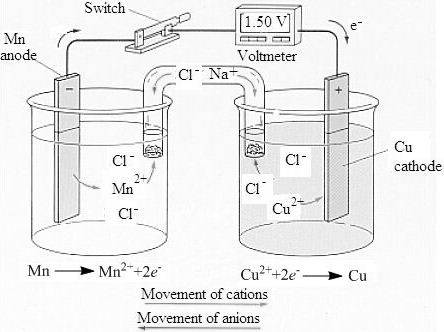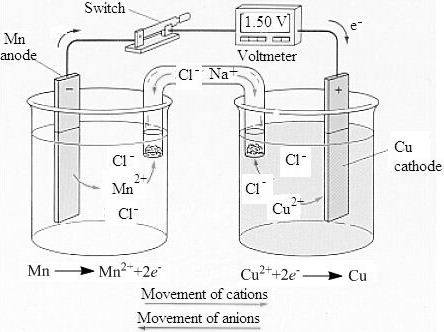
Concept explainers
(a)
To determine: Sketch of a labeled voltaic cell and the concentration of the solution.
(a)
Answer to Problem 1DE
The labeled sketch of the voltaic cell is,

The concentration of the copper and the manganese ion is
Explanation of Solution
Given
The electrical potential output of the cell is
The external device draws the current of
The electric potential of the cell is calculated as,
According to the above equation, the difference in the oxidation and the reduction potential should be
The standard oxidation potential of manganese is
Therefore, the pair of manganese and copper is used to construct a voltaic cell with manganese being anode at which oxidation takes place and copper being cathode at which reduction takes place.
The standard reduction potential is the potential of the electrode dipped in the aqueous solution of its ion of concentration
Therefore, the concentration of the copper and the manganese ion is
We are given the beaker of the capacity of
The volume of the solution of manganese and copper ion is assumed to be
The labeled sketch of the voltaic cell is,

- Figure. 1
The mass of the manganese in the
Substitute the value of molar concentration, molar mass and the volume of the solution of manganese in the above equation.
The mass of the copper in the
Substitute the value of molar concentration, molar mass and the volume of the solution of copper in the above equation.
Therefore, the mass of manganese and copper present in the
The concentration of the copper and the manganese ion is
(b)
To determine: The concentration of manganese and copper ion in the solution after
(b)
Answer to Problem 1DE
Explanation of Solution
Given
The electrical potential output of the cell is
The external device draws the current of
The charge transport is calculated by the formula,
Substitute the value of current and time in the above formula,
Charge on each electron is
The moles of electron present in
Substitute the value of charge transfer, charge on each electron and Avogadro’s number in the above formula.
Two electron transfer takes place by oxidation and reduction of manganese and copper, respectively.
Therefore, the change in moles of manganese and copper is:
The initial concentration of the ions is
Thus, one mole of ion is present in one liter of the solution and
The number of moles of manganese ion increase due to oxidation of metal. Therefore, the molar concentration of manganese ion in
The number of moles of copper ion increase due to oxidation of metal. Therefore, the molar concentration of copper ion in
Thus, the concentration of manganese and copper ion after two hours is
The concentration of manganese and copper ion after two hours is
(c)
To determine: The voltage that a cell register at the end of the discharge.
(c)
Answer to Problem 1DE
Explanation of Solution
Given
The electrical potential output of the cell is
The external device draws the current of
The concentration of manganese and copper ion after two hours is
The standard oxidation potential of manganese is
The standard reduction potential is the potential of the electrode dipped in the aqueous solution of its ion of concentration
Thus, one mole of manganese ion gives the oxidation potential of
Therefore,
One mole of copper ion gives the reduction potential of
Therefore,
The electric potential of the cell at discharge is calculated as,
Substitute the value of oxidation and reduction potential in the above equation.
Thus, the end cell potential is
The end cell potential is
(d)
To determine: The time taken for the reactant of one cell to get completely consumed.
(d)
Answer to Problem 1DE
Explanation of Solution
Given
The electrical potential output of the cell is
The external device draws the current of
The charge transport is calculated by the formula,
Substitute the value of current and time in the above formula,
Charge on each electron is
The moles of electron present in
Substitute the value of charge transfer, charge on each electron and Avogadro’s number in the above formula.
Two electron transfer takes place by oxidation and reduction of manganese and copper, respectively.
Therefore, the change in moles of manganese and copper is
Charge is directly proportional to time at constant current flow.
The charge transferred is
The total initial concentration of the reactant of one half cell is one molar.
Therefore, the charge transfer of one molar takes place in
The charge transfer of one molar takes place in
Want to see more full solutions like this?
Chapter 20 Solutions
EP CHEMISTRY:CENTRAL..-MOD.MASTERING
- For each reaction below, decide if the first stable organic product that forms in solution will create a new CC bond, and check the appropriate box. Next, for each reaction to which you answered "Yes" to in the table, draw this product in the drawing area below. Note for advanced students: for this problem, don't worry if you think this product will continue to react under the current conditions - just focus on the first stable product you expect to form in solution. དྲ。 ✗MgBr ? O CI Will the first product that forms in this reaction create a new C-C bond? Yes No • ? Will the first product that forms in this reaction create a new CC bond? Yes No × : ☐ Xarrow_forwardPredict the major products of this organic reaction: OH NaBH4 H ? CH3OH Note: be sure you use dash and wedge bonds when necessary, for example to distinguish between major products with different stereochemistry. Click and drag to start drawing a structure. ☐ : Sarrow_forwardPredict the major products of this organic reaction: 1. LIAIHA 2. H₂O ? Note: be sure you use dash and wedge bonds when necessary, for example to distinguish between major products with different stereochemistry. Click and drag to start drawing a structure. X : ☐arrow_forward
- For each reaction below, decide if the first stable organic product that forms in solution will create a new C - C bond, and check the appropriate box. Next, for each reaction to which you answered "Yes" to in the table, draw this product in the drawing area below. Note for advanced students: for this problem, don't worry if you think this product will continue to react under the current conditions - just focus on the first stable product you expect to form in solution. NH2 tu ? ? OH Will the first product that forms in this reaction create a new CC bond? Yes No Will the first product that forms in this reaction create a new CC bond? Yes No C $ ©arrow_forwardAs the lead product manager at OrganometALEKS Industries, you are trying to decide if the following reaction will make a molecule with a new C-C bond as its major product: 1. MgCl ? 2. H₂O* If this reaction will work, draw the major organic product or products you would expect in the drawing area below. If there's more than one major product, you can draw them in any arrangement you like. Be sure you use wedge and dash bonds if necessary, for example to distinguish between major products with different stereochemistry. If the major products of this reaction won't have a new CC bond, just check the box under the drawing area and leave it blank. Click and drag to start drawing a structure. This reaction will not make a product with a new CC bond. G marrow_forwardIncluding activity coefficients, find [Hg22+] in saturated Hg2Br2 in 0.00100 M NH4 Ksp Hg2Br2 = 5.6×10-23.arrow_forward
- give example for the following(by equation) a. Converting a water insoluble compound to a soluble one. b. Diazotization reaction form diazonium salt c. coupling reaction of a diazonium salt d. indacator properties of MO e. Diazotization ( diazonium salt of bromobenzene)arrow_forward2-Propanone and ethyllithium are mixed and subsequently acid hydrolyzed. Draw and name the structures of the products.arrow_forward(Methanesulfinyl)methane is reacted with NaH, and then with acetophenone. Draw and name the structures of the products.arrow_forward
- 3-Oxo-butanenitrile and (E)-2-butenal are mixed with sodium ethoxide in ethanol. Draw and name the structures of the products.arrow_forwardWhat is the reason of the following(use equations if possible) a.) In MO preperation through diazotization: Addition of sodium nitrite in acidfied solution in order to form diazonium salt b.) in MO experiment: addition of sodium hydroxide solution in the last step to isolate the product MO. What is the color of MO at low pH c.) In MO experiment: addition of sodium hydroxide solution in the last step to isolate the product MO. What is the color of MO at pH 4.5 d.) Avoiding not cooling down the reaction mixture when preparing the diazonium salt e.) Cbvcarrow_forwardA 0.552-g sample of an unknown acid was dissolved in water to a total volume of 20.0 mL. This sample was titrated with 0.1103 M KOH. The equivalence point occurred at 29.42 mL base added. The pH of the solution at 10.0 mL base added was 3.72. Determine the molar mass of the acid. Determine the Ka of the acid.arrow_forward
 ChemistryChemistryISBN:9781305957404Author:Steven S. Zumdahl, Susan A. Zumdahl, Donald J. DeCostePublisher:Cengage Learning
ChemistryChemistryISBN:9781305957404Author:Steven S. Zumdahl, Susan A. Zumdahl, Donald J. DeCostePublisher:Cengage Learning ChemistryChemistryISBN:9781259911156Author:Raymond Chang Dr., Jason Overby ProfessorPublisher:McGraw-Hill Education
ChemistryChemistryISBN:9781259911156Author:Raymond Chang Dr., Jason Overby ProfessorPublisher:McGraw-Hill Education Principles of Instrumental AnalysisChemistryISBN:9781305577213Author:Douglas A. Skoog, F. James Holler, Stanley R. CrouchPublisher:Cengage Learning
Principles of Instrumental AnalysisChemistryISBN:9781305577213Author:Douglas A. Skoog, F. James Holler, Stanley R. CrouchPublisher:Cengage Learning Organic ChemistryChemistryISBN:9780078021558Author:Janice Gorzynski Smith Dr.Publisher:McGraw-Hill Education
Organic ChemistryChemistryISBN:9780078021558Author:Janice Gorzynski Smith Dr.Publisher:McGraw-Hill Education Chemistry: Principles and ReactionsChemistryISBN:9781305079373Author:William L. Masterton, Cecile N. HurleyPublisher:Cengage Learning
Chemistry: Principles and ReactionsChemistryISBN:9781305079373Author:William L. Masterton, Cecile N. HurleyPublisher:Cengage Learning Elementary Principles of Chemical Processes, Bind...ChemistryISBN:9781118431221Author:Richard M. Felder, Ronald W. Rousseau, Lisa G. BullardPublisher:WILEY
Elementary Principles of Chemical Processes, Bind...ChemistryISBN:9781118431221Author:Richard M. Felder, Ronald W. Rousseau, Lisa G. BullardPublisher:WILEY





